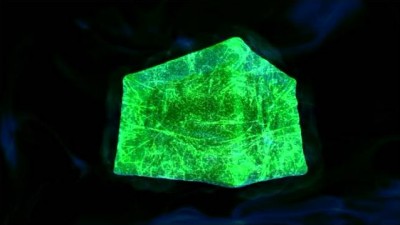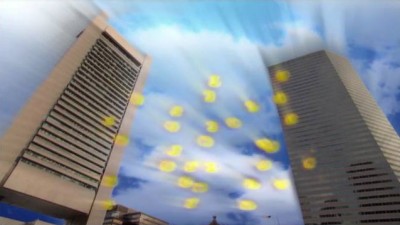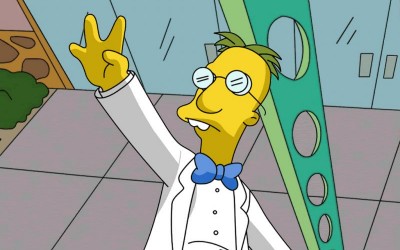THROUGH THE WORMHOLE: Are There More Than 3 Dimensions? with Physicist Joe Polchinski
Mike Vicic - June 29, 2011

Tonight at 10pm ET/PT on Science, Morgan Freeman introduces viewers to the world's brightest minds who are convinced they are on the verge of unraveling the Universe's true number of dimensions.
Despite living in a world of 3D movies, the true number of dimensions is definitely not three. Most people agree that time is the fourth dimension, forming the space-time continuum that most sci-fi shows invoke to explain time travel. Most scientists, including pre-eminent physicist Joe Polchinski from the University of California - Santa Barbara, believe there are at least 10 dimensions.
Ten dimensions. Just try wrapping your head around that, then watch tonight's episode of THROUGH THE WORMHOLE WITH MORGAN FREEMAN to help you better visualize what it really means. To help us -- and you -- Polchinski took time out of his busy day to speak with us about D-branes, gravitons and Professor Frink.
In the mid 1990s, Polchinski's work reinvigorated string theory as well as the hopes for a grand unifying theory that describes the four fundamental interactions: gravity, electromagnetic, weak and strong forces. When he showed that D-branes had certain electromagnetic properties, Polchinski found a way to explain how, and where, unlooped strings attach their loose ends.

Joe Polchinski. University of California, Santa Barbara.
Photo courtesy of: Science / THROUGH THE WORMHOLE.
How should we think about these D-branes? D-branes, or branes for short, are just membranes. Something like a blanket that keeps you warm on a cold winter night by separating you from the cold room air. Polchinski says, "The usual way to visualize the brane is thin in one direction and long in the other two." He continues, "The shape they take depends on what's happening," and they may be sheets, like that winter night's blanket, or they may wrap back on themselves and form a spherical shell like a racquetball. In tonight's program, you'll see branes visualized as something akin to a shoebox or a spider web, but they do have other forms. Unfortunately, Polchinski didn't see the final cut of the episode, and he couldn't comment on specific aspects of its graphics.

A graphical interpretation of a brane, with strings inside that traverse
and connect to the faces of the brane.
Photo courtesy of: Science / THROUGH THE WORMHOLE.
Even though the program leaves viewers with the impression that branes are relatively stable and stagnant -- at least that was the impression I had -- that conclusion couldn't be further from the truth. Polchinski stresses that these objects are dynamic. He says, "Because space is homogeneous, branes are free to explore. There are interesting effects in the motions of branes. There's a lot of interest in the inflationary universe and the microscopic dynamics that drive inflation." Basically, these branes vibrate, like your blanket moves as you breathe while you sleep, and they exhibit bulk motion, just as when you throw your blanket off the bed in the morning.
Later in the episode, Lisa Randall, Professor at the Harvard University Department of Physics, uses two close-by skyscrapers to represent different branes so she can discuss graviton movement between branes and why gravity is so weak in our world. In string theory, gravitons have a closed-loop configuration. Since these loops don't have either end attached to a brane, gravitons are free to move in the space between branes. Besides gravitons, what else exists between these branes? Polchinski says that space might be curved but the space is otherwise empty, which means the visuals aren't too bad, except for the size of the animated gravitons.

The two buildings represent branes and the yellow objects are
gravitons moving from the building on the right to the one on the left.
Photo courtesy of: Science / THROUGH THE WORMHOLE.
Just remember that the building-as-brane analogy is very limiting -- these branes can take many shapes, are constantly moving and are actually much closer to each other. Polchinski continues, "Before Randall's work, we would've said that all of these length scales would be Planck scale [10-35 meters] but the separation between branes can be as large as microns [10-6 meters]." That means the actual distance between these building branes is only 1% the diameter of a single human hair, and it's that tiny gap that separates parallel universes. And what about the size of those gravitons? Well, there's a reason why the program uses oversized graphics -- in Randall's visual analogy, the gravitons would be a billion, billion times smaller than the size of the gas molecules between those two towers.
Throughout the program, Freeman introduces the world's premier researchers who are acquiring data at the CERN Large Hadron Collider, in space, and underground to determine whether strings and branes actually exist. As you'll hear, scientists can't measure these strings and branes directly since they're so small, but they do investigate properties and features that strings and branes affect.
Will we soon have data to prove that string theory is correct? Polchinski, a theoretical physicist, doesn't share the same hopes as his experimentalist colleagues featured in this episode. He adds, "I'm a pessimist. I see each of these as a long shot. We have to explore all of them." From my perspective, we buy a handful of string-theory lottery tickets every time we fund a new experiment. Each project will produce many small winners -- data that incrementally increases our understanding of quantum physics and cosmology -- but the probability of winning the jackpot -- irrefutable evidence that strings and branes exist -- is relatively small. But it's possible. And isn't that why people play the lottery? There's a chance, and the next ticket could be the one.
Now we're left with the ultimate question. Are there more than three dimensions? To quote Polchinski's favorite TV scientist, Prof. Frink on THE SIMPSONS: "Well, it should be obvious to even the most dim-witted individual who holds an advanced degree in hyperbolic topology." I think that means "Yes."

Professor Frink from THE SIMPSONS, showing
the number of spatial dimensions that we see everyday.

